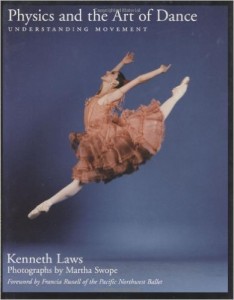Oxford University Press (March 14, 2002)
 Written by a physicist with professional dance training, Physics and the Art of Dance explains how dancers can achieve better, safer performances through an understanding of physics in motion. Using simple, non-technical terms, Kenneth Laws combines his knowledge of both physics and dance to describe how the laws of gravity, momentum, and energy affect dancing bodies. The book explores the natural laws that govern the subtleties of balance, the techniques of leaps and pirouettes, and the impressive lifts and turns executed by ballet partners. Finally, Laws offers insight into two current discussions in the dance world–the effect of body size on ballet technique, and the relationship between science and the art of dance.
Written by a physicist with professional dance training, Physics and the Art of Dance explains how dancers can achieve better, safer performances through an understanding of physics in motion. Using simple, non-technical terms, Kenneth Laws combines his knowledge of both physics and dance to describe how the laws of gravity, momentum, and energy affect dancing bodies. The book explores the natural laws that govern the subtleties of balance, the techniques of leaps and pirouettes, and the impressive lifts and turns executed by ballet partners. Finally, Laws offers insight into two current discussions in the dance world–the effect of body size on ballet technique, and the relationship between science and the art of dance.
Beautiful, original stop-action photographs by Martha Swope, along with clear diagrams, illustrate the concepts described in the text. Plus, an intriguing “puzzler” at the beginning of each chapter provides an engaging entrée into the topics presented. For those who want a more advanced understanding of the physics, extensive appendices are provided.
This new book combines the best features of Laws’s widely acclaimed The Physics of Dance and Physics, Dance, and the Pas de Deux by Laws and Cynthia Harvey. Its expert application of the basic principles of physics to the art of dance will be an invaluable resource for dancers and dance instructors and will open a new level of appreciation for lovers of the form. It will also appeal to physicists who seek to include the arts in their scientific pursuits.
